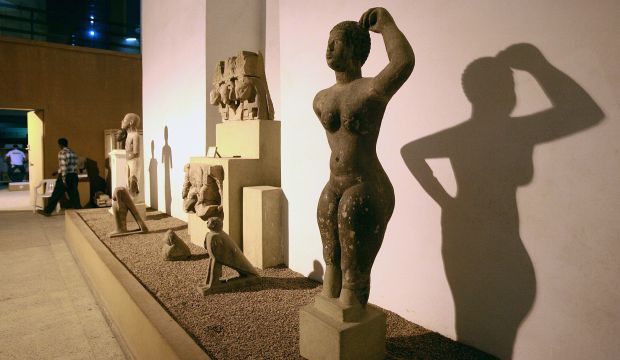
Ancient sculptures are displayed at the Sudan National Museum in the Sudanese capital Khartoum.
(Khaled Desouki/AFP/Getty Images)
Khartoum, Asharq Al-Awsat—One of the more strange thefts in the history of the Sudan National Museum took place when a sandalwood tree worth more than half a million US dollars was stolen from the museum’s garden last weekend.
The thief used an electric saw to cut the tree into pieces before carrying it out through a nearby gate. The wood from the tree, an Indian sandalwood, is estimated to be worth as much as 4 million Sudanese pounds (700,000 US dollars).
The tree also has historical value as it was planted on the day the museum’s foundation stone was laid in 1962. The museum was originally established to salvage Sudanese antiquities that would be submerged in Lake Nasser as a result of the construction of the Aswan High Dam in Egypt. At the time UNESCO led a rescue operation to retrieve the relics in the Nubia region, and the museum was inaugurated in May 1971 during the tenure of late President Gaafar Nimeiry.
The museum also contains treasures from Sudan’s ancient kingdoms, and later Christian and medieval periods.
Ghalya Garalnabi, secretary-general of the museums department, said that the latest theft was unusual because thieves usually go for gold or ancient relics. In 2003, 54 antiquities were stolen from the museum in a single sweep but were later recovered by the authorities and returned to the museum. Other thefts saw mostly golden objects taken from the exhibition hall. As a result, the museum’s gold is no longer on display and is now kept in a safe, says Garalnabi.
Garalnabi believes that the presence of foreign archaeologists in Sudan has increased the number of thefts as stolen antiquities can be valued and sold on through middlemen who then take them out of the country.
However, some of these smuggled pieces sometimes make their way back to Sudan and the museum.
“International cooperation towards tracking down stolen antiquities has contributed greatly to the recovery of Sudanese antiquities,” said Garalnabi. She mentioned that the UK’s Metropolitan Police had unearthed items from the Sudan National Museum that were being put up for sale in shops in London, including pieces that date back to the Kingdom of Kush. The Kingdom of Kush extended along the Nile, encompassing southern Egypt and modern day Sudan, from the ninth century BCE to the fourth century CE.
